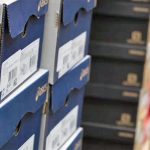Duluth Trading estimated that delivery delays cost the company between $15 to $20 million in revenues in the fourth quarter ended January 30, but strong full-price sales helped earnings surpass expectations.
On a conference call with analysts, Sam Sato, Duluth’s president and CEO, said the company’s ability to deliver record sales, adjusted EBITDA, earnings and free cash flow in the full-year highlights the progress being made under its Big Dam Blueprint improvement program “on seizing market growth opportunities while also highlighting where we can make even greater gains.”
The plan includes shifting to a digital-first focus, reducing reliance on promotions and spreading its focus from primarily a single brand of Duluth Trading Company to a family of brands under the Duluth Trading Company umbrella. The brands so far include Duluth by Duluth Trading Company, its workwear line; AKHG (formerly Alaskan Hardgear), aimed for outside recreation needs, and Best Made, a curated men’s apparel and crafted hard gear acquired in 2020.
In the near term, however, supply chain disruption will weigh on results in the coming quarters.
For the first quarter, sales are expected to decline in the low to mid-teens percent due to slow receipts on spring and summer seasonal goods as well as lower clearance inventory levels.
“Although inventory flow remains slower than normal, which we expect will impact sales in the first half of 2022, we are beginning to see some early signs that gives us confidence that supply chain congestion will improve by the second half of the year,” said Dave Loretta, Duluth’s CFO and SVP.
To adjust to the delivery shortfalls, Duluth is making adjustments to the spring collection events and marketing promotions. Duluth is also taking steps to pull forward inventory flow where possible, place earlier delivery dates with vendors, diversify its ports of entry to avoid bottlenecks and prepare to selectively expedite orders to maintain in-stock positions in key items and seasonally sensitive products. Added Loretta, “The good news is inbound receipts have accelerated, giving us confidence that the supply chain congestion is improving.”
Duluth predicted sales overall in 2022 would recover in coming quarters to rise in the mid-to-high single digits for the full year.
The lower clearance levels partly reflect low receipts but also Duluth’s structural shift to focus more on full-price selling and less on promotional or clearance sales in order to better maximize turns and profitability. Duluth’s clearance inventory at the quarter’s end was less than 10 percent of total inventory compared to 25 percent last year with the total amount clearance down 68 percent year over year.
On the positive side, the strength of full-price selling and managing with fewer clearance goods is expected to support 400 basis points of gross profit margin growth in the first quarter with quarter-to-date margins running “significantly higher” year over year.
In the fourth quarter, sales increased 5.8 percent to $270.8 million, falling short of Duluth’s guidance in the range of $272.2 million to $287.2 million. The inventory shortfalls caused inventory in the quarter to run below last year’s levels by as much as 25 percent. Sales were up 4.3 percent compared to the same period in 2019.
Retail store sales increased 32.8 percent to $91.1 million as traffic recovered versus pandemic-impacted levels last year. Store traffic increased 15 percent to last year in the quarter. Direct-to-consumer (DTC), or online and catalog sales, declined 4.1 percent to $179.7 million against elevated year-ago comparisons while growing 10.3 percent over 2019. Web visits increased 7 percent year over year.
By product category, men’s apparel sales increased 7.0 percent while women’s apparel decreased 3.7 percent. The increase in men’s was due to strength in core year-round items. The decrease in women’s was primarily attributed to inventory delays resulting in gaps in woven tops.
Gross margins improved 80 basis points to 53.8 percent. A higher mix of full-price sales from lower clearance inventory and successfully dialing back promotion activity offset $6 million of expedited freight costs.
SG&A increased 15.5 percent to $121.4 million and grew as a percent of sales to 44.9 percent from 41.1 percent in the corresponding prior-year period. The increase was primarily due to increased advertising expense as investments were reduced the prior year due to amid the pandemic, coupled with higher personnel costs and elevated outside services costs in part due to progressing on initiatives tied to the Big Dam Blueprint.
Net income slid 20.2 percent to $17.4 million, or 53 cents, from $21.8 million, or 67 cents, a year ago, but topped Duluth’s guidance in the range of 44 cents to 49 cents due to the gross margin improvement. Adjusted EBITDA decreased 14.1 percent to $33.0 million due to the greater investment in marketing and personnel to support the shifts in its strategic brand positioning and longer-term growth objectives. The incremental expedited freight costs also dragged down earnings.
For the full year, sales increased 9.4 percent to $698.6 million, just below Duluth’s guidance in the range of $700 million to $715 million. Gross margin increased to 54.0 percent compared to 51.9 percent in the prior year. Net income improved 118 percent to $29.7 million, or 90 cents, exceeding guidance in the range of 81 cents to 86 cents. Adjusted EBITDA climbed 41.6 percent to $77.4 million, above guidance in the range of $73 million to $75 million.
On the call, Sato highlighted progress on the Big Dam Blueprint program that’s designed to reach Duluth’s goal of $1 billion in sales by 2025. The company has also set a goal to achieve its prior best operating margin of 9 percent to 10 percent. Last year, operating margins reached 6.3 percent, up from 3.8 percent in fiscal 2020.
Sato noted that direct-to-consumer sales accelerated in 2021, more than doubling the annual growth rate to 9.4 percent, resulting in two-year growth of 13.5 percent.
Duluth’s 12-month active buyer file is 14 percent larger than it was two years ago and marked the first time the mix has tilted to buyers who have been purchasing with Duluth for greater than two years. Said Sato, “These buyers represent our most loyal, longstanding customers.”
Duluth acquired a significant number of new customers during the year with new buyers coming from the retail channel up 22 percent over last year. Said Sato, “The shifts we made during the year to scale spend on digital media platforms and reduce reliance on print and linear TV continues to drive efficiencies and increased awareness.”
On product, the women’s division particularly has leveraged the success of Armachillo and Dang Soft fabrics into several first layer categories.
“Our highly successful CoolMax technology has been blended with the Duluth Double Flex canvas in jackets pants and overalls,” said Sato. “One of our most successful women’s pant launches this fall included an expanded assortment of the Daily Denim collection. This premium denim provides the flex and shape that are in high demand along with the durability and resiliency to stand up to frequent wear.”
In men’s, Duluth launched Funk No! underwear and recently introduced Controlroom boxer briefs both items with technology that regulates body temperature and offers odor resistance. Like women’s, fabric technologies such as Armachillo Dang Soft have been designed into lighter-weight hoodies, fleece and joggers for men. Men’s core DuluthFlex workwear line that includes fire hose pants, CoolMax overalls, and a wider assortment of lined pants were among best sellers this fall/winter season.
Duluth also announced it recently signed a long-term lease on a new fulfillment center located in Adairsville, GA. Expected to be operational in late summer 2023, the facility will have the capacity for up to 40 percent of Duluth’s annual direct volume and will reduce average delivery time in half for the southeast region that extends west to Texas and north along the entire eastern seaboard. The new facility will join a warehouse opened in Salt Lake City in the third quarter to support delivery on the west coast. Upgrades are also planned this year in its other two facilities in Wisconsin and Iowa to support online growth.
Said Sato, “our 2022 expense plans contemplate deeper investment in our organizational capabilities with the goal of evolving our business to have a digital-first mentality, both in how we operate and how we engage with our customers. Our belief is that to be competitive in our space, we must meet our customers where they are and anticipate where they’re going. For this, we need our teams to model the digital mindset.”
Photo Duluth Trading
















